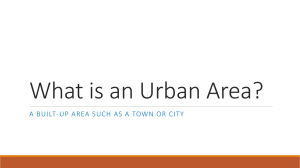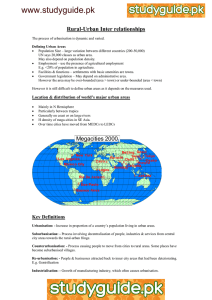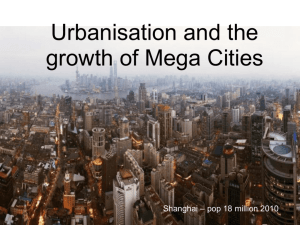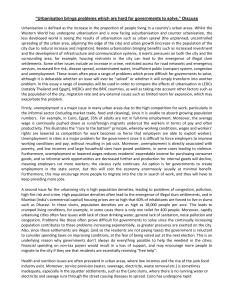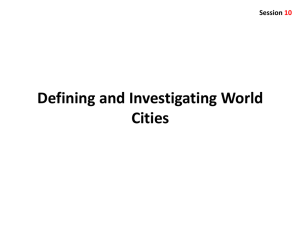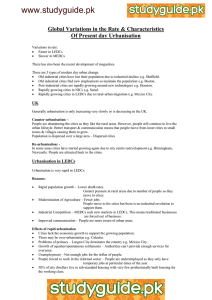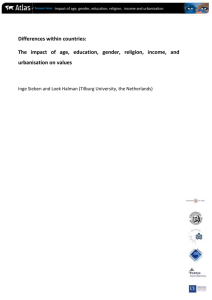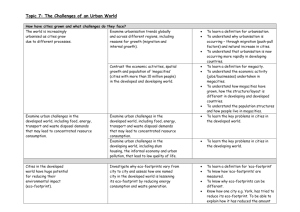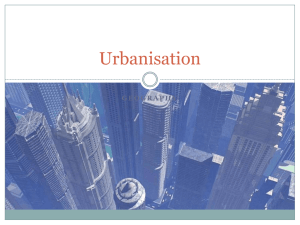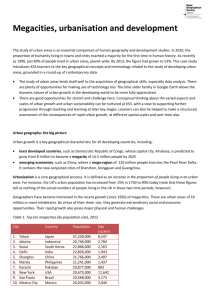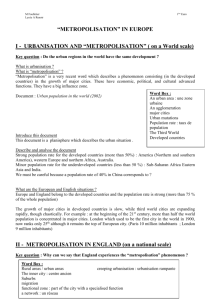What is urbanisation? - Miss Woodhead
advertisement
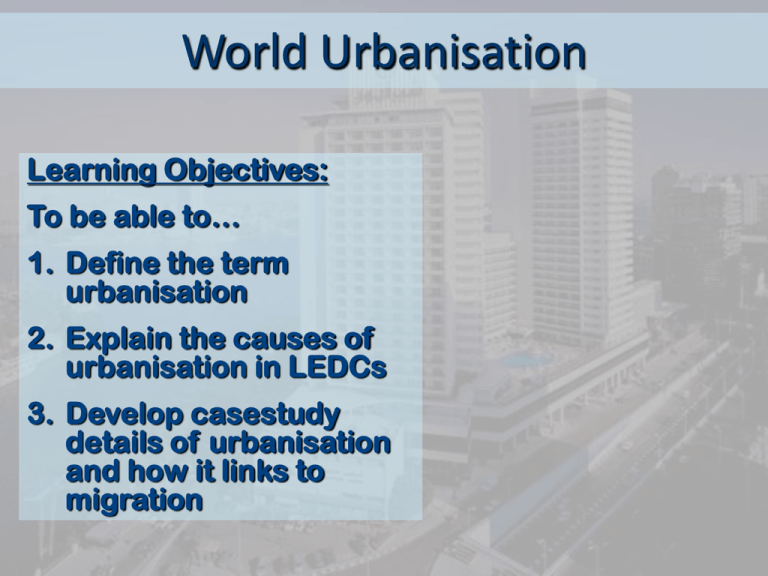
World Urbanisation Learning Objectives: To be able to… 1. Define the term urbanisation 2. Explain the causes of urbanisation in LEDCs 3. Develop casestudy details of urbanisation and how it links to migration What is urbanisation? Discuss on your tables what you think urbanisation is Present this in the form of a spider diagram in the back of your books Most developed countries urbanised in the late 1800s What is urbanisation? In 1800 only 3% of the population lived in cities Gathered pace from 1950 onwards Urbanisation is the increase in proportion of people living in cities and towns Mostly happening in LEDCs In 1950 29% of the world’s population lived in cities "the process by which there is an increase in the proportion (not number) of people living in urban areas” Homework- Due Thursday 4th October • • • • Go to www.misswoodhead.weebly.com Click on Population and Settlement page Open the Counter Urbanisation File Follow the instructions on page 3, using the Counter Urbanisation PowerPoint on the website rather than going onto the VLE • Create a Counter Urbanisation Case Study Key World Cities Terms Millionaire Cities : cities with over 1m inhabitants Megacities : cities with over 10 m inhabitants (20 in 2009, 15 are in LEDCs) World Cities : cities which have a major impact on world events. Often major financial centres (London, New York, Singapore, Tokyo) or major political centres (Washington, Beijing, Moscow), or major cultural centres (Los Angeles, Paris) The push from the countryside: The pull of the cities: •Lack of jobs other than poorly paid farm work •Chances of regular paid work •Lack of services such as doctors •Chances of better health services and schools. •Lack of opportunity for life to be better for your children •Chances of a more interesting life •Better prospects for children to survive and thrive •Desperation to avoid starvation in the rural areas. •Rapid RURAL-URBAN migration is one of the main causes of rapid city growth in LEDCs •Cities in S. America have passed their fastest growth rate. •Cities in Asia are growing at their fastest at the moment •Cities in Africa have yet to grow at the maximum rate •Cities in N. America and Europe are DECLINING as people choose to leave them... This is called… SHANTY TOWNS Names given: •Favelas •Bustees •Squatter Settlements Materials Mud, straw, corrugated iron, cardboard, wood, plastic sheeting, tiles, basic building blocks / bricks Origin of people Where? Typically found on cheap Unwanted land near rivers Or railways or places prone To landslides Where poor migrants have come to set up basic homes using whatever materials they can – e.g. Mexico City Community: Sense of community Everyone is in it together Chance of starting a self help •Most are rural migrants •They move in steps – from rural areas to small towns – then large towns – then cities Conditions and problems •Few doctors in their local area – have to travel a long way •Poor infrastructure (roads) – eg South Africa •Water has initially to be collected – not piped to the house •Long hours – low pay – eg taxi drivers •Education costs and often have to send children a long way in the city Video on Urbanisation http://www.youtube.com/watch?v=HGAGr0yZP Y4&playnext=1&list=PL0459319AE5F2A54B&fea ture=results_video Rural push factors Problems Urban pull factors Solutions Urbanisation in Cairo, Egypt Push Factors - from countryside • Drought in desert • Unreliable weather, bad for growing crops, no water • Unreliable water supply, runs out • No jobs • Unpleasant conditions Pull Factors - to urban areas • Irrigated, fertile land on the Nile delta • reliable water supply • “bright lights of city” effect • job opportunities • inertia - if people move, others will follow • New, modern European additions to the city, such as Parisian style boulevards and commercial centres, as well as bridges and transport links • New suburbs built • Egypt becomes free of European control Urban Problems • Strain on services demand for piped water, sewers, schools, paved roads and electricity • Traffic congestion, air pollution and water pollution • Housing shortages people live in ‘The City of the Dead’ = old cemetery • Lack of permanent jobs • illegal housing is built on ‘green’ land, and protected farmland • overcrowding, lack of basic sanitation and poor refuse collection, in temperatures of 40oC +, leads to disease and illness. • 3 million people now live in the city of the dead in the tombs of old Cairo • people are squatters on rooftops of office buildings and flats in home made huts • Private landlords illegally add extra storeys to their existing blocks of flats • rich poor imbalance - very few rich, many poor • no enforcement of catalytic converters on cars, or unleaded fuel, this leads to toxic smog • low pay for jobs, and unskilled jobs are hard to come by • polluted sewage water raises the water table, and rots the foundations of buildings Solutions • Gentrification improving city • Building a new sewage system (greater Cairo sewage project) • Zabbaleen people given official contract to collect waste and sewage • New satellite and dormitory town are built in areas around Cairo • a massive new ring road and metro system have been built • waste is seen as a resource • a drop in birth rate may be the best solution long-term Case-Study of a rapidly urbanising city Lagos, Nigeria, W. Africa What are the consequences of rapid urbanisation? Lagos, Nigeria Background •Nigeria is the economic power-house of West Africa with vast natural resources •Nigeria is the most populated country in Africa with 149m people. The urban/rural balance is 48:52 •Nigeria’s population is one of the fastest growing in the world with a doubling rate of 22 years. Over half the population is under the age of 20. •Lagos used to be the capital of Nigeria, but the more central Abuja became the new capital in 1991 •Lagos is one of the fastest growing mega-cities in the world. Due to become the world’s 3rd largest city in 2010 Plenary • Come up with a sentence which uses as many key words as possible • The person with the most key words wins some haribo!
